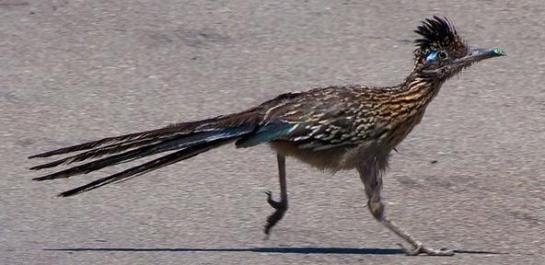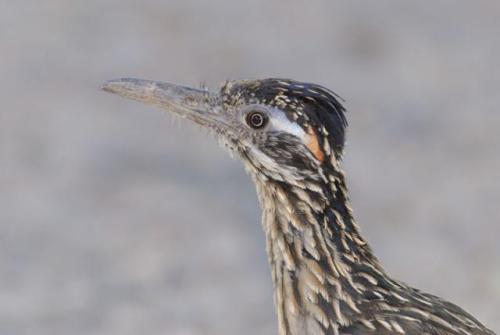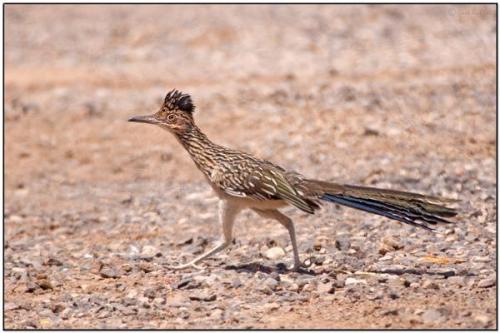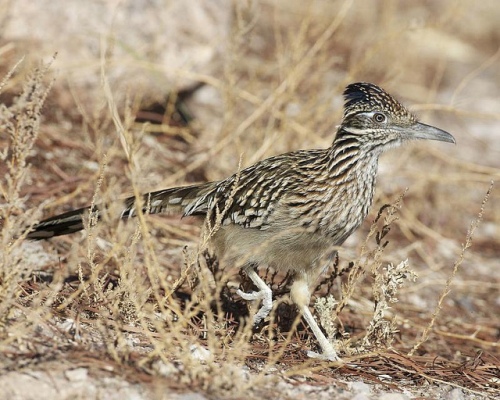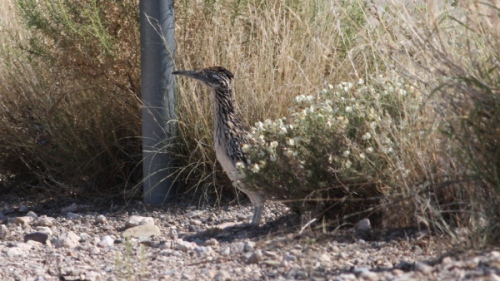Roadrunners: Made for Running!
Dr. James J. S. Johnson
But they that wait upon the LORD shall renew their strength; they shall mount up with wings as eagles; they shall run, and not be weary; and they shall walk, and not faint.
( Isaiah 40:31)
Therefore, seeing we also are compassed about with so great a cloud of testifying-witnesses [μαρτυρων ], let us lay aside every weight, and the sin which doth so easily beset us, and let us run with patience the race that is set before us.
( Hebrews 12:1 )

Seeing a Greater Roadrunner (Geococcyx californianus, a/k/a Chaparral Bird) scampering about in the grass, near the east side of my lawn, last Friday (12 May, A.D.2023), reminded me of the hidden-in-plain-view miracle of running. Roadrunners are cuckoo-like birds, capable of flight yet more famous for on-the-ground running (including chasing and catching insects and reptilian prey), easily recognizable by their skinny-chicken-looking bodies, sporting long tails, scissors-like beak, and prominent crest feathers.

( photo credit: MSN.com News / Bonnie Blink )
And Roadrunners are quick! (See, e.g., “Sneaky Roadrunner”, posted at https://leesbird.com/2014/07/09/sneaky-roadrunner/ — and also see “Dueling with a Diamondback i the Desert: ROADRUNNER vs. RATTLESNAKE!”, posted at https://leesbird.com/2017/05/23/dueling-with-a-diamondback-in-the-desert-roadrunner-vs-rattlesnake/ .)
For a recent news report on a snake-eating roadrunner, see Robyn White’s “Hungry Bird Takes on Venomous Snake—and Wins””, posted at http://www.msn.com/en-us/news/us/hungry-bird-takes-on-venomous-snake-and-wins/ar-AA1bcKQQ?ocid=msedgntp&cvid=e9fb24f6a0bc45f8b2e00754820428c0&ei=14 .

( photo credit: Wikipedia / Jessie Eastland )
Running is an astounding activity, although we rarely think of running that way. (And chasing is even more amazing, because it involves 2 creatures running at the same time, with one trying to catch while the other tries to escape!). However, if we only saw an animal–or a human–running once in a lifetime we might recognize the physiology of running as the God-given miracle that is. But, because we see creatures run about, frequently, we lose sight of how astonishing the action of running really is.
Running requires coordinated and energetic movement, integrating purpose, distance, and body parts and systems working together with teamwork (see 1st Corinthians chapter 12), so the bioengineering needed to enable running is an energetic and ongoing exhibit of the Lord Jesus Christ’s empowering genius and wisdom. (See, accord, Randy J. Guliuzza, “Made in His Image: Beauty in Motion”, posted at http://www.icr.org/article/beauty-motion# .)
Children assume that running is normal; grandparents watch runners with nostalgia, remembering when sprinting felt effortless. Running, if and when it is accomplished with ease, is a blessing–the ability to run is a marvelous gift from our God Who invented the ability to run. In fact, the Lord gave the gift of running to more than just human children, and athletes who are older than children–He gave the gift of running to many of the animal He created.

Among mammal s, notable runners include feline family (such as cheetah, jaguar, and cougar, sprinting at speeds near 70 mph!), antelope-like beasts (such as pronghorn, springbok antelope, and Indian blackbuck antelope, reaching speeds of 50 to 60 mph), wildebeest (running at 50 mph), and even bats (such as free-tailed bat, flying at 60 mph!). Other fast-footed mammals include the African lion and the hare (both climaxing at almost 50 mph, and running longer distances at lesser speeds), as well as the African wild dog and Australia’s kangaroo (both climaxing at almost 45 mph).
But, what about birds? Many birds move at speeds that are mind-boggling, such as the figure-eight wing-beating of hummingbirds, which appear as blurs to the watching eyes of human spectators–some capable of speeds above 40 mph!)..
Likewise, birds can fly at high speeds, both horizontally and especially when “dive-bombing” (a/k/a stoop diving) downward—think of falcons (e.g., Peregrine Falcon, with horizontal speeds up to almost 70 mph, and diving speed above 240 mph!). Likewise, eagles are famous for their speed (e.g., Golden eagle, with horizontal speed near 30 mph, and diving speed near 200 mph).
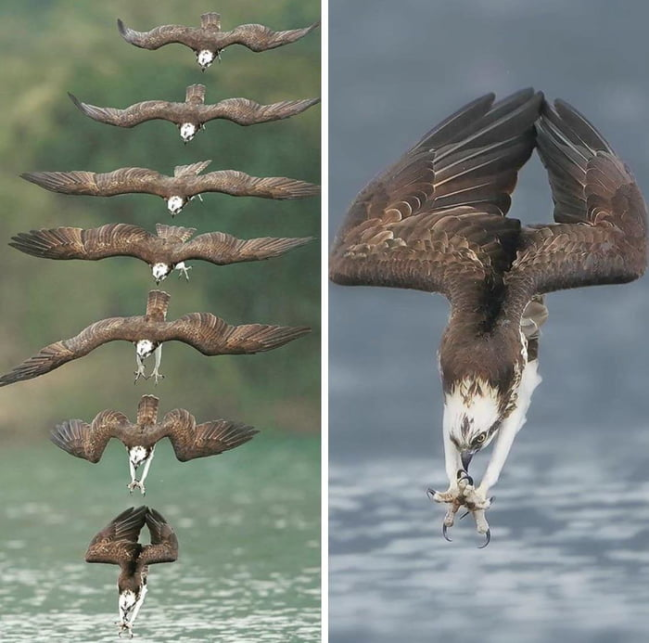
Indeed, the Holy Bible refers to the eagle’s speedy flight more than once.
Saul and Jonathan were lovely and pleasant in their lives, and in their death they were not divided: they were swifter than eagles, they were stronger than lions.
( 2nd Samuel 1:23 )
Our persecutors are swifter than the eagles of the heaven: they pursued us upon the mountains, they laid wait for us in the wilderness.
( Lamentations 4:19 )
Yet birds can be rapid runners on ground, too–with the Roadrunner being the classic example of a bird famous for running.
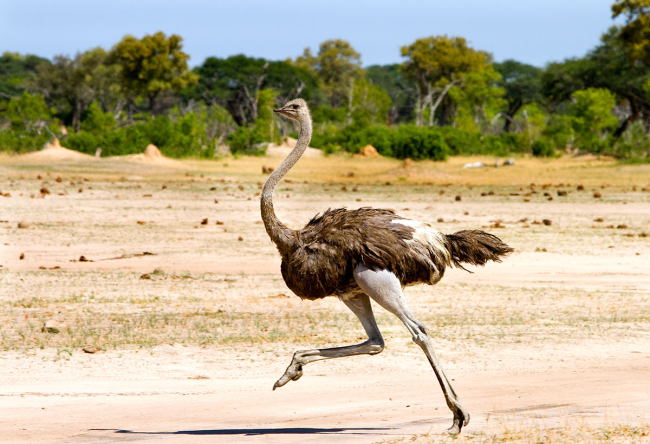
Actually, Africa’s Ostrich runs faster, achieving speeds up to 43 mph (with some reports of quick sprint-bursts up to 60 mph!), qualifying the Ostrich as the fleetest terrestrial runner among birds! Ostriches have stamina, too, so they can sustain speeds above 30 mph for a half-hour or even longer–no human can do that! Behind the Ostrich, Australia’s Emu (a smaller ratite) zooms by, racing at speeds above 30 mph.

Yet the Greater Roadrunner, a much smaller bird, can dart about at speeds above 25 mph–faster than even fleet-footed children.
So, you get the picture–running is a big deal! On that note I’ll quit–i.e., rest–because I ‘got tired” just thinking about all of those creatures running to and fro. Actually, to be frank, I NEVER GET TIRED! Why? I don’t “get tired” because I stay tired.
:)

( photo credit: Wikipedia / drumguy8800 xvisionx.com )
Having arrived at this blogpost’s “finish line”, I’ll contribute this limerick:
STARTLED BY A ROADRUNNER ZIGZAGGING IN THE GRASS
After filling my mower with gas,
I was cutting my east lawn’s grass;
Whoa! — it gave me a start!
‘Twas a bird that did dart!
Wow! Texas roadrunners run fast!

(photo credit: Wikipedia / El Brujo+ )
